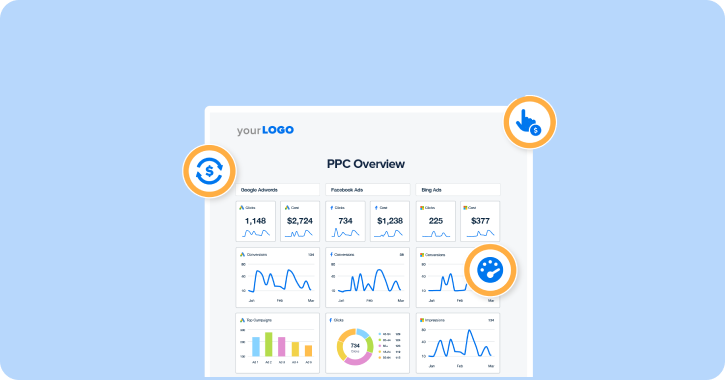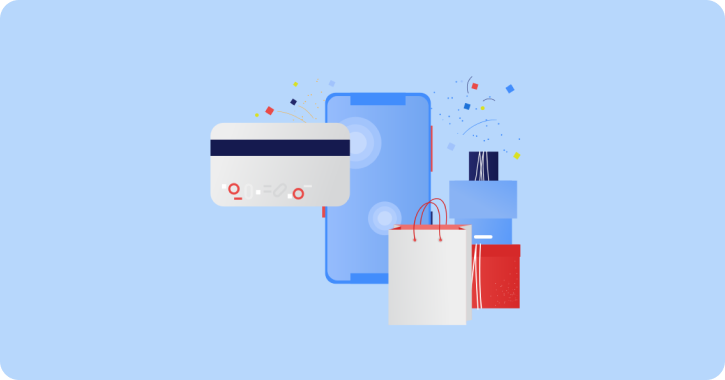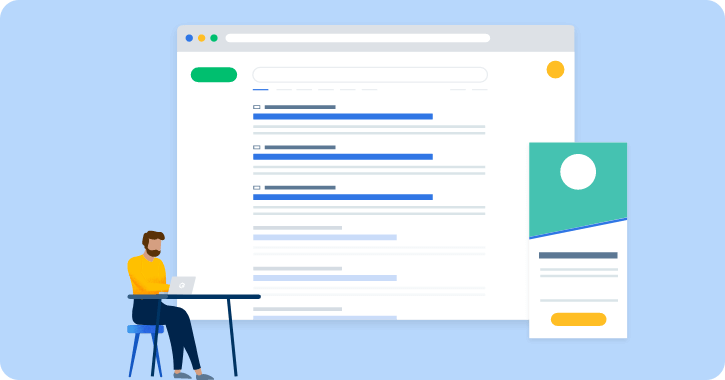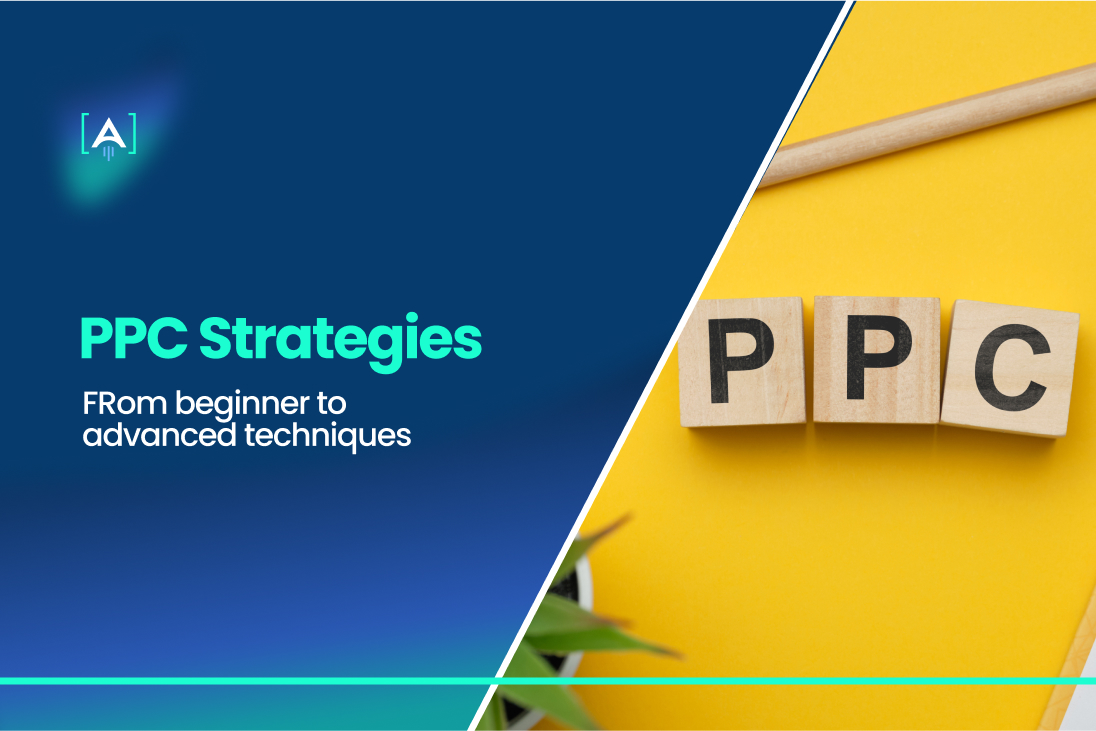
If you’re stuck on your current PPC strategies, you’ve come to the right place!
As a leading PPC marketing agency, we are here to show you beginner-level techniques and advanced techniques to take your campaigns from average to jaw-droppingly awesome.
We will walk through how each PPC strategy works and give you hands-on advice for setting up campaigns with success.
Challenge yourself to try something unique and see your ROI skyrocket in no time with the help of these PPC strategies!
What is PPC, and How Does It Work

PPC, or Pay-Per-Click, is the process of an online advertising model. Businesses advertise their goods and services through this marketing technique on search engines, websites, and blogs.
The advertiser pays a certain fee each time someone clicks on the ‘ad’ button, thus ensuring continued visibility for the business’s product or service.
It also allows users to track successes more accurately since it records activity every time someone clicks on one of the PPC ads presented.
PPC marketing allows businesses to bid for ad space within a specific area, like Google or Bing, with other companies targeting the same audience to guarantee surefire visibility for their PPC ads.
This way, competing businesses are interested in different web pages that audiences visit more commonly.
Setting up a pay-per-click campaign requires careful planning from the advertiser, usually looking at budget-relevant options with strategic keywords that target their specific audience.
Using these keywords allows them to appear among the top-ranked must-read items of any given search engine, providing them good exposure and bid opportunities they did not have previously while avoiding being associated with irrelevant content that hurt their placement in searches.
PPC is a simple yet targeted online marketing strategy that helps grow awareness between potential customers and consistently desired events.
Some of the PPC Terms You Need to Know

With the ever-evolving world of PPC, staying on top of the latest and greatest in terminology is essential.
Here are some key terms you should familiarize yourself with before diving into your next campaign:
CPM (Cost per Mille)
Also known as Cost Per thousand Impressions, it is an advertising model where a business pays for every one thousand impressions that their ad receives.
This model allows businesses to reach large audiences while keeping track of their campaigns’ performance through metrics such as conversion rates and return on investment (ROI).
The cost per mille varies greatly, depending on factors such as industry and targeted audience size.
CTR (Click Through Rate)
CTR is a common metric used to measure the effectiveness of an online advertisement or search engine result listing by counting how many times users clicked through compared to how many times the page was viewed or searched for.
The higher the CTR, the more likely users find the content relevant and click through to learn more about it or take action.
Conversion Rate
Conversion rate is another important metric when measuring digital marketing performance, as it indicates how successful each campaign has converted visitors into customers or subscribers.
Conversion rate measures how many people who visited a website completed an intended action from that website; these actions can range from making an online purchase to signing up for a mailing list, downloading content, etc.
A high conversion rate typically indicates that users found the content compelling enough to take action based on it.
Quality Score
Quality score is Google’s proprietary algorithm used to determine which paid ads should be ranked higher than others in its search results pages based on historical data such as clicks and conversion rates, as well as user engagement metrics like bounce rate and time spent on site.
Ads with higher quality scores will appear more often than those with lower scores—helping businesses get better visibility and improve ROI over time without increasing bids unreasonably high to compete against other advertisers in the same space.
Ad Group
An ad group is a collection of related keywords within an overall advertising campaign structure within Google Ads (formerly known as Adwords).
Groups can include multiple PPC ads targeting different geographic locations, device types, or keywords with different bids attached so that you can customize your approach according to each keyword set’s individual performance history.
That will allow businesses maximum control over allocating resources across campaigns without having to redo entire campaigns every time they want changes made.
Add Text
This term refers specifically to copy written for PPC campaigns within Google Ads.
Copywriting plays an essential role in PPC campaigns because effective text helps convey your message quickly and efficiently while engaging readers and inspiring them to take action, whether purchasing something from your store or signing up for your newsletter.
Writing good ad text requires some skill; generally speaking, you want short but descriptive sentences free of jargon that accurately convey what exactly it is you’re offering viewers while still being eye-catching enough.
So they take notice/click on your ad instead of others around them!
Ad Rank
Ad rank is a metric used by Google to determine where an ad should be placed on a search engine results page (SERP).
Ad rank considers factors such as CPC, quality score, and landing page experience.
A higher ad rank will result in your ad being placed higher on the SERP, while a lower ad rank will result in your ad being placed lower on the SERP- and potentially not being seen at all.
Having a higher ad rank can help your business increase visibility and generate more leads, so it’s important to understand how to improve your ad rank by optimizing your landing pages and improving the quality score of your PPC ads.
PPC Metrics

These metrics are essential for understanding how your digital marketing campaigns are performing and where improvements can be made.
By understanding the different types of PPC metrics and their importance to the overall success of your campaigns, you can accurately measure results, improve ROI, and maximize the effectiveness of your overall digital marketing efforts.
Here are some of the most important PPC metrics you should be tracking:
Cost Per Acquisition (CPA)
This metric considers the amount of money spent on a campaign and the number of conversions or sales.
You can easily determine your CPA rate by dividing the total cost by the total number of acquisitions.
Knowing this information allows you to adjust your campaigns to increase ROI and decrease CPA over time.
Average Order Value (AOV)
Average order value measures how much money customers spend on each purchase in an e-commerce store.
This metric can help marketers understand customers’ spending habits and optimize their ad campaigns accordingly.
A higher AOV means more profit for the business, while a lower AOV usually indicates that customers need help finding what they want or need from the advertised product range.
Return on Investment (ROI)
Return on investment is a crucial metric for any business looking to optimize its campaigns for success.
This metric helps businesses measure how much profit their campaigns generated compared to how much was spent on them—allowing them to make smarter decisions regarding budgeting and resource allocation moving forward.
Return on Advertising Spend (ROAS)
ROAS is an essential metric for measuring how successful a company’s ad spend is in generating sales and revenue for its business.
It compares gross revenue generated with the amount spent on advertising, giving businesses an accurate idea of whether or not their campaigns are successful at driving sales.
This also helps them reach their desired goals quickly and efficiently while minimizing overall costs incurred in marketing process efforts.
Benefits of Using Pay-Per-Click Advertising
Pay-Per-Click advertising is an effective way of reaching a wide audience quickly without having to wait for organic search engine rankings to improve.
It also allows businesses to target specific demographics and audiences with tailored messages, enabling them to increase their conversion rates and ROI over time.
Here are some of the benefits of using PPC strategy:
Immediate Results
One of the biggest benefits of using PPC strategy is that you can immediately see results.
Once your campaign is live, your ads will start appearing on search engine results pages (SERPs), and you will begin to generate clicks and traffic.
This is in contrast to SEO, which can take months or even years to produce results.
Greater Control Over Your Budget
With the right PPC strategy, you have greater control over your budget than other forms of marketing.
With most PPC platforms, you can set a daily budget and bid amount, which means you will only spend what you are comfortable with.
This level of control can be helpful if you are working with a limited marketing budget.
More Targeted Traffic
A PPC strategy allows you to be very specific regarding who sees your PPC ads.
For example, you can target ads to users based on their location, age, gender, interests, and even past search history.
This level of targeting ensures that your ads are seen by the ones who are more likely to be interested in what you offer.
Increased Brand Awareness
Another benefit of PPC advertising is that it can help to increase brand awareness for your business.
When people see your ads on SERPs or other websites, they will become familiar with your brand and what you offer.
This increased awareness can lead to more website visitors and customers over time.
More Flexible than Other Forms of Marketing
A PPC strategy is also more flexible than other forms of marketing, such as print or television advertising.
With PPC, you can easily adjust your campaign based on changes in your business or goals.
If you want to target a new audience or change your ad copy, you can do so quickly and without hassle.
Provides Valuable Data
Another benefit of using PPC is that it provides valuable data that can be used to improve your marketing efforts.
With most PPC platforms, you can track click-through rate (CTR), conversion rate, and cost per click (CPC).
This data can be extremely helpful in identifying what is working and what needs to be refined in your campaign.
Overall, PPC is a powerful tool that can help a business of any size reach its goals and maximize its return on investment.
Understanding how to optimize your ad campaigns can ensure you are getting the most out of your PPC efforts.
The Best PPC Platforms for Your Business

Now that you know the benefits of PPC, you may be wondering which platform is best for your business.
The answer to this question will depend on several factors, such as your budget, goals, and target audience.
For example, Google Display Network (GDN) and Facebook Ads are both popular platforms for businesses looking to maximize their ROI.
Here are some of the most popular Pay-Per-Click platforms for businesses:
Google Ads
Google Ads is the world’s largest and most widely used pay-per-click (PPC) advertising platform.
With Google Ads, businesses of all sizes have access to a powerful suite of tools that help them reach their marketing goals.
Google Ads interface offers various targeting options, including search, display, video, shopping, and more.
It also provides robust reporting data to help you understand your campaigns’ performance and make adjustments as needed.
With its sophisticated algorithms and massive reach, Google Ads is an excellent choice for any business looking to grow its online presence.
Bing Ads
Bing Ads is Microsoft’s answer to Google’s PPC platform.
Although Bing doesn’t have quite the same reach as Google, it does offer some advantages that make it a great choice for businesses looking to maximize their return on investment (ROI).
Bing has many advanced targeting options, such as demographic targeting, device targeting, and more, that allow you to laser-target your ads for maximum effect.
Additionally, Bing’s reporting features allow you to track conversion rates from different sources so you can tailor your campaigns accordingly.
Facebook Ads
Facebook Ads is an extremely powerful PPC platform that allows businesses to target potential customers with incredible precision.
Facebook’s Ad Manager makes creating custom campaigns tailored specifically to your business’s goals and objectives easy.
Businesses can select from a wide range of ad formats, including images, videos, and carousels that are sure to capture the attention of their target audience.
The detailed analytics available through Facebook’s Ad Manager also makes it easy to monitor ad performance in real-time so you can make adjustments on the fly if needed.
Instagram Ads
Instagram Ads offer businesses a great way to reach potential customers through this powerful channel.
Instagram ads allow businesses to create visually stunning posts featuring images or videos that capture peoples’ attention, whether scrolling through their feeds or watching stories on Instagram.
Various targeting options such as location, age, gender, and interests make it easy for businesses to show highly relevant ads only to those who are likely interested in what they have offered.
Twitter Ads
Twitter Ads give businesses access to millions of users around the globe who are actively engaged with the platform.
That makes them an ideal audience for many campaigns, including direct response campaigns like website clicks or conversions or brand awareness campaigns meant to spread awareness about their brand or product.
Twitter also has some incredibly detailed analytics, making it easier for advertisers to measure campaign performance over time and adjust their strategies accordingly.
Amazon Advertising
With Amazon Advertising, you can access a huge network of shoppers to promote your business and products.
It allows you to use the powerful targeting tools from Amazon’s marketplace to find customers more likely to be interested in your products.
With this platform, you can create compelling display ads, search ads, and sponsored products that drive traffic and sales.
Additionally, it offers advanced reporting capabilities to get insights into the performance of your campaigns.
AdRoll
AdRoll is a great platform for advanced PPC users looking for more control over their campaigns.
It offers many different ad formats, including display and video ads that you can customize with personalized messages and images tailored specifically to target audiences or customer demographics.
This platform also gives you access to detailed analytics to track your campaigns’ performance and make changes accordingly to maximize ROI.
AdRoll also allows you to set up retargeting campaigns so you can re-engage visitors who have previously visited your website but have yet to take action.
Taboola
Taboola is another popular PPC platform for marketers looking for fast results.
With Taboola, you can create highly targeted ads designed specifically for mobile devices that will reach users across a wide range of websites and apps in multiple countries worldwide.
The platform also offers powerful analytics tools to measure your campaigns’ success by tracking user engagement metrics such as click-through rate (CTR), impressions, cost per click (CPC), etc., helping you optimize your budget much more efficiently than other platforms.
Taboola has its dedicated support team available to answer any of your questions or address issues related to using their service anytime, day or night, via email or phone.
Outbrain
Outbrain is a great option for businesses looking for a comprehensive PPC solution covering all aspects of their digital marketing needs, such as display advertising, SEO, and content recommendation networks (CRN).
It provides easy-to-use targeting tools ranging from location data-driven targeting based on geographic locations where customers are active online.
This helps to granular demographic data like age range or gender breakdowns allowing users to target potential customers more effectively than ever before.
Outbrain also features real-time reporting tools that enable marketers to monitor campaign performance metrics such as impressions served, CTRs achieved, conversions tracked, etc.
It gives them invaluable insights into how their campaigns are performing against goals set before the launch date, allowing them to make informed decisions about future actions taken regarding adjustments made from now on if needed.
Keywords & Their Match Types

Keywords are an essential part of any PPC ad campaign.
They are the words or phrases that you use when targeting customers so they can find your ad in search results.
With keywords, you can specify different “match types,” which determine how closely related a search query needs to be for your ad to appear.
The four main match types are exact match, phrase match, broad match, and negative match.
Let�’s discuss each one in more detail.
Exact Match
Exact match is the most restrictive match type, meaning that your ad will only show when someone searches for your exact keyword or a close variation.
Thus, you get the most targeted traffic possible from exact match keywords, but it also means that your ad will have fewer impressions.
For example, if you are targeting the keyword “SEO guide,” your ad will only show when someone searches for “SEO guide” or a close variation such as “guide to SEO.”
Phrase Match
A phrase match is less restrictive than an exact match but more restrictive than a broad match.
With phrase match, your ad will show when someone searches for your exact keyword or a close variation that includes additional words before or after your keyword.
So with the keyword “SEO guide,” your ad will show when someone searches for “guide to SEO,” but it won’t show when someone searches for just “SEO.”
Broad Match
Broad match is the least restrictive match type, meaning that your ad may show when someone searches for your keyword or a close variation of it.
For example, with the keyword “SEO guide,” your ad may show when someone searches for “how to do SEO” or “SEO tips and tricks.”
However, with a broad match, you may get a lot of irrelevant traffic, so you should be sure to use it wisely.
Negative Match
A negative match is the opposite of a broad match – it allows you to exclude certain keywords so that your ad will not appear when those keywords are searched.
For example, if you target the keyword “SEO guide” and don’t want your ad to appear in SERP when someone searches for “paid SEO services,” then you can use a negative match to exclude that phrase.
This way, you can ensure that the most relevant customers only see your ad.
With the right keywords and match types, you can ensure that your PPC ad campaigns hit the right target audience and achieve maximum ROI.
Targeting Alternate Keywords

When it comes to targeting alternate keywords, many marketers’ minds jump instantly to the primary keyword they have identified to target.
However, simply limiting your focus solely to this keyword phrase may be missing out on a treasure trove of potential opportunities!
By harnessing the power of underlying themes and related terms, brands can truly expand their reach, elevate their content and engage a larger customer base more deeply.
For instance, if you are trying to target a keyword like “SEO techniques,” you could consider alternate keywords such as “SEO best practices” or “search engine optimization tactics.”
By targeting these related terms in addition to your primary keyword, you can capture more of the relevant traffic and ensure your campaigns are performing optimally.
At the same time, you can also monitor how different keywords affect your campaign performance so you can continue refining and optimizing your PPC strategy.
By leveraging alternate keywords, you can easily expand the reach of your campaigns and maximize your ROI with minimal effort.
So make sure to include alternate keywords in your campaigns for maximum success!
Building Effective PPC Campaigns
Building effective campaigns requires a mix of knowledge, experience, and creativity.
When constructing your campaigns, key elements should be considered, such as keyword selection, ad copywriting, and optimizing your bid and PPC strategy.
Follow these steps to ensure your campaigns are successful:
Define Your Goals
The first step in building an effective PPC campaign is to define what you hope to achieve.
This could be anything from increasing brand awareness, driving site traffic, or generating more leads and sales.
Once you have a clear goal in mind, you’ll be better able to design your campaign to help you reach those objectives.
Research Your Keywords
It’s important to do thorough keyword research when creating a PPC campaign.
You want to ensure that the keywords you’re targeting are relevant to your business and will attract the right customers.
Consider using tools such as Google Trends or keyword research tools like Ahrefs or SEMRush to help identify potential keywords and phrases with higher search volumes that would make good targets for your campaigns.
Create Compelling Ad Copy
Once you’ve identified the best keywords for your campaign, it’s time to start crafting compelling ad copy around them.
Writing effective ad copy requires not only creativity but also thoroughness-length ad copy containing more details and facts. Higher semantic richness is often more successful than shorter versions because it conveys more information about the advertised product or service.
Additionally, because search engine algorithms tend to favor longer-form content, writing ads 50% longer than usual can boost your chances of appearing near the top of SERPs, which can result in increased click-through rates and conversions for your campaigns.
Choose the Campaign Type
When setting up your Pay-Per-Click campaigns, selecting the most appropriate campaign type for your goals is important.
Search Ads are an excellent way to reach potential customers who are actively looking for what you offer.
Search Ads are the most common types of campaigns and can be used for various objectives, such as driving brand awareness or generating leads.
Display Ads use visuals and text to catch the attention of people who may still need to learn they need what you have to offer.
By creating eye-catching designs and effective messages, display PPC ads can turn new customers into loyal followers of your business.
Shopping Ads allow businesses to show their products directly within search engine results pages or other websites that potential customers might visit.
This allows customers to purchase items directly from their search results or other web pages without ever having to leave the page they are on.
Video Ads advertising is one of the best methods to engage with potential customers and explain why your business matters in a relatively short amount of time.
With video ads, you can make sure viewers understand how your products or services work and why they should choose yours over others’ offerings before they even click away from the page they are on.
Native Ads allow businesses to blend in with existing content on a website by using similar styling and formatting that readers would expect from organic content.
This advertising takes advantage of user familiarity with certain websites and creates an almost seamless transition between browsing experiences and advertisements.
This makes it easier for potential customers to learn more about what you have available.
Set Up Your Campaign
This step involves setting up and configuring all of the necessary components of your campaign.
You’ll need to decide on a budget, select targeting options such as geographic areas or demographic groups you’d like to target, and create ad groups that contain sets of related keywords.
You should also set up conversion tracking so you can measure the performance of your campaigns and adjust accordingly.
Monitor and Optimize Your Campaign
Once your PPC campaign is set up, it’s time to track its performance closely.
Regularly review reports for metrics such as impressions, clicks, cost per click (CPC), average position, and conversions to gain insights into how effective each ad is performing.
This data can help you identify areas of improvement so you can optimize your ads accordingly with changes like better ad copy, more relevant targeting, or a reduced CPC to make the most of your budget.
PPC Ad Formats
Your campaigns come in various formats, each of which has strengths and weaknesses.
So, let’s look at a few popular formats;

Standard Text Ads
Standard text ads are a classic and popular form of Pay-Per-Click advertising that allows advertisers to communicate their message quickly and effectively.
These simple yet powerful ads include a headline, two description lines, and a display URL to direct users to the appropriate landing page.
This straightforward format allows advertisers to create compelling campaigns that drive clicks, conversions, and revenue.
Expanded Text Ads
Expanded text ads offer more than double the amount of space compared to standard text ads, giving advertisers more room to impact their target audience.
This ad format includes an additional headline, description line, and a longer URL field so you can craft longer messages or use more specific URLs in your campaigns.
Expanded text ads also allow for better targeting by adding additional ad extensions like review stars and callouts to highlight your brand’s key features and benefits.
Product Listing Ads
Product listing ads are designed for e-commerce retailers that want to showcase their products directly within SERPs.
By integrating product images, titles, prices, and other relevant details into each ad unit, product listing ads provide shoppers with all the information they need at a glance.
That will make them more likely to click through for additional product information or conversion opportunities on your site.
Local Service Ads
Dedicated local service ads enable businesses focused on local services (e.g., plumbing or home cleaning) to make their services visible within SERPs in certain markets worldwide without having a website presence.
Each local service ad includes basic info about the business, such as its name, address, phone number, and rating score – allowing potential customers in the area to quickly discover what you offer without ever leaving Google’s network.
Call-Only Ads
By allowing advertisers to combine their campaigns with specific call tracking numbers, call-only ads make it easier than ever for prospective customers who prefer calling over web browsing/emailing/chatting for inquiries about goods or services available from businesses that offer phone support.
Plus, these streamlined ad units don’t require special formatting or creative assets since they already include all the necessary details – making it easy for any advertiser to take advantage of this great ad format option.
Responsive Text Ads
As one of Google’s most versatile PPC ad formats available today, responsive text ads require less time for setup and deliver greater performance opportunities compared to other traditional PPC formats.
It is largely due to its ability to automatically adjust copy based on user device type while ensuring high relevance levels throughout each user’s journey with your brand.
In addition, responsive text ads take up valuable real estate at the top of SERPs when users perform searches related to your products or services, making them an essential part of any comprehensive PPC strategy.
More Tips for a Quality PPC Strategy
Set Up Conversion Tracking
By setting up conversion tracking, you can accurately measure and compare different campaigns and make adjustments accordingly.
By taking advantage of various tools available, such as Google Analytics or AdsBridge, you can track different metrics like cost-per-click (CPC), click-through rate (CTR), impressions, page views, time on page, and more.
Having this data allows you to optimize your campaigns for better results.
Optimize Your Landing Pages

A key component of any successful PPC campaign is a well-optimized landing page.
If your landing pages aren’t optimized properly, it could result in low-quality scores and lower click-through rates – causing your overall costs to increase.
It’s important to ensure that all elements of your landing page are optimized, from the design and layout to the call-to-action (CTA), and even the content itself should be relevant and engaging so that visitors are more likely to convert.
Test and Optimize
Testing is essential to get the most out of your campaigns, particularly regarding ads and the keywords used in them.
You can test different versions of your ad with slight variations in wording or placement to see which performs best for your desired goal (CTR or conversions).
A/B tests should be conducted regularly to improve upon click-through rate (CTR) consistently, cost per click (CPC), quality score (QS), conversions, etc., ensuring maximum return on investment (ROI).
Finally, remember always to monitor metrics such as impressions and clicks to fully understand how people are engaging with your ads across different channels.
Maximize Your ROI
To maximize your ROI with PPC advertising, you must ensure that you target the right audience and use the right keywords.
With the right targeting and optimization, you can ensure that your ads are seen by the right people at the right time – potentially leading to an increase in conversions.
The key is to focus on the right metrics, such as quality score (QS), cost per click (CPC), and conversions, to ensure that you consistently get a return on your investment.
Make Bid Adjustments
Every business should consider optimizing their bids for the greatest chance of success in their campaigns.
This includes setting the right bid for each keyword and making adjustments to ensure you appear for the most relevant searches and get optimal results.
Consider using automated bidding tools to help you find the perfect balance between cost-effectiveness and performance.
Try Extensions
Extensions are a great way to add more depth to your ads, improving visibility, click-through rate (CTR), and conversions.
They allow you to include additional information such as location, product ratings, special offers, or contact information in your ad copy that can give potential customers more confidence before they click on your ad or potentially take further action.
Ensure your ads have all relevant extensions enabled to stand out from competitors and achieve better engagement rates.
Great PPC Tools to Consider
With the right tools, you can make optimizing your campaigns much easier.
Here are some great tools to consider:
AdWords Keyword Planner is an invaluable tool for researching and strategizing for campaigns.
It allows users to enter keywords into their search query and receive detailed information about each keyword, such as its monthly search volume, competition level, and the average cost per click.
This tool also provides suggestions for related keywords that could be beneficial for targeting potential customers.
Google Trends is another great tool for researching keywords and trends in online searches.
It tracks web search activity across various regions and languages over time so marketers can gain insights into how target audiences search online.
You can identify seasonal trends that may affect your campaigns or even uncover topics that may resonate with users more than others.
Google Keyword Planner is similar to AdWords Keyword Planner but with added features like “Ad Group Ideas,” which suggests ad groups based on the entered keyword(s).
This makes it easier to structure your campaigns while giving helpful insight into what words perform best in ads related to those keywords.
Ubersuggest is valuable if you’re looking for ideas beyond simple keyword research.
It takes a seed keyword and uses it as inspiration for content ideas, blog post titles, backlink opportunities, competitive analysis, website audit reports, etc., which are invaluable when planning a well-rounded campaign PPC strategy.
WordStream is another excellent tool that helps optimize your marketing campaigns by determining where you should spend money on ads versus organic SEO efforts.
It provides useful data such as average ad positions, cost per click (CPC), impressions, etc., which are important factors when budgeting a campaign budget.
With WordStream, you can get personalized insights on optimizing your ad spending while saving money on clicks that don’t convert into sales or leads.
SEMRush offers an array of features, including competitive analysis where you can compare your campaigns against competitors and see what strategies they are using which could help inform yours; discovery of new keywords, tracking the progress of current campaigns; as well as numerous other valuable metrics used in creating successful digital marketing strategies.
Databox is an especially handy tool because it aggregates data from multiple sources (eCommerce platforms like Shopify or WordPress analytics apps) into one responsive dashboard.
This allows marketers greater access to real-time insights into their performance metrics in one organized place so they can make informed decisions quickly and accurately about their PPC strategies in the future.
Learn to Get Noticed in the Crowded Market
As soon as you understand the basics of PPC strategies, your journey has just begun. From there, you can move on to more advanced PPC techniques, such as using negative keywords and creating tighter ad groups.

This can lead you to unlock higher conversion rates, ROI, and brand recognition.
You’ll quickly see that the amount of knowledge and creativity needed to develop effective PPC strategies knows no bounds – each campaign is unique, so you must constantly learn, test, and adjust to stay ahead of the competition.
Though it may seem like a daunting task at first, with practice and research, completing successful Pay-Per-Click campaigns will become second nature in no time!
With Azarian Growth Agency’s paid search marketing services, you don’t have to worry about any tedious aspects of PPC, like setting up and managing campaigns.
We will work with you to identify your target audience and design and create customized ad campaigns tailored to their specific needs.
We also provide ongoing support for your campaigns to ensure that you always get the best results from your marketing efforts.

